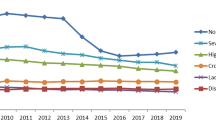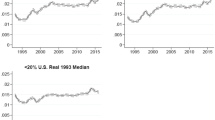Abstract
Area-based markers of deprivation (e.g., postal codes) are commonly used to identify groups of people with low socioeconomic status (SES); the validity of this approach, however, remains unknown. In this study, we determined the accuracy of using income quintile groups calculated on the basis of the median family income of each forward sortation area (1996 Canadian census) to identify those living in poverty (i.e., annual family income of < $12,620). The sensitivity and specificity of using the lowest income quintile to capture those in poverty were 26% and 83%, respectively (likelihood ratio (LR) of 1.49; 99% CI, 1.49 to 1.50). Among those in non-metropolitan and metropolitan areas, the LRs were 1.26 (99% CI, 1.26 to 1.27) and 2.01 (99% CI, 2.01 to 2.02), respectively. The use of postal codes as the only marker to identify people with low SES may result in substantial misclassification of personal poverty, particularly in nonmetropolitan areas.
Résumé
On utilise communément les indicateurs de dénuement fondés sur la zone (p. ex., le code postal) pour définir les groupes de gens dont le statut socio-économique (SSE) est faible, mais on ignore encore la validité d’une telle approche. Dans notre étude, nous avons déterminé le degré d’exactitude de l’emploi de quintiles de revenus calculés selon le revenu familial médian dans chaque région de tri d’acheminement (Recensement canadien de 1996) pour identifier les personnes vivant sous le seuil de pauvreté (revenu familial annuel <12 620 $). La sensibilité et la spécificité de l’emploi du quintile de revenus inférieur pour identifier ces personnes étaient de 26 % et de 83 %, respectivement (rapport des vraisemblances (RV) de 1,49; IC 99 %, 1,49 à 1,50). Pour la population à l’extérieur des régions urbaines et en zone métropolitaine, les RV étaient respectivement de 1,26 (IC 99 %, 1,26 à 1,27) et de 2,01 (IC 99 %, 2,01 à 2,02). L’emploi du code postal comme seul indicateur des gens à faible SSE pourrait donc entraîner d’importantes erreurs de classement de la pauvreté individuelle, surtout à l’extérieur des régions urbaines.
Similar content being viewed by others
References
Pappas G, Queen S, Hadden W, Fisher G. The increasing disparity in mortality between socioe-conomic groups in the United States, 1960 and 1986. N Engl J Med 1993;329(2):103–9.
Andrulis DP. Access to care is the centerpiece in the elimination of socioeconomic disparities in health. Ann Intern Med 1998;129(5):412–16.
Ward P, Morton-Jones AJ, Pringle MA, et al. Generating social class data in primary care. Public Health 1994;108(4):279–87.
Alter DA, Naylor CD, Austin P, et al. Effects of socioeconomic status on access to invasive cardiac procedures and on mortality after acute myocar-dial infarction. N Engl J Med 1999;341(18):1359–67.
Krieger N. Overcoming the absence of socioeco-nomic data in medical records: Validation and application of a census-based methodology. Am J Public Health 1992;82(5):703–10.
McLoone P, Ellaway A. Postcodes don’t indicate individuals’ social class. BMJ 1999;319(7215):1003–4.
National Council of Welfare (Canada). Sounding the alarm: Poverty in Canada. Ottawa: Parliament. Senate, 1998; 48–96 (ISBN 0-662-26727-3).
Alberta Health and Wellness. AHIP; Premium and Rates. Available at www.health.gov.ab.ca/ahcip/premiums.htm.
Statistics Canada. Census Metropolitan Area, Census Agglomeration and Census Tract (CMA/CA/CT) Reference Maps, 1996 Census. Ottawa: 92F0092XPB, 1997.
Salit SA, Kuhn EM, Hartz AJ, et al. Hospitalization costs associated with homeless-ness in New York City. N Engl J Med 1998;338(24):1734–40.
Lynch JW, Kaplan GA, Pamuk ER, et al. Income inequality and mortality in metropolitan areas of the United States. Am J Public Health 1998;88(7):1074–80.
Wilkinson RG. Unhealthy Societies: The Afflictions of Inequality. London: Routledge, 1996.
Demissie K, Hanley JA, Menzies D, et al. Agreement in measuring socio-economic status: Area-based versus individual measures. Chron Dis Can 2000;21(1):1–7.
Kaplan GA, Seeman TE, Cohen RD, et al. Mortality among the elderly in the Alameda County Study: Behavioral and demographic risk factors. Am J Public Health 1987;77(3):307–12.
Marmot M, Bobak M, Smith GD. Explanations for social inequalities in health. In: Amick BC III, Levine S, Tarlov AR, Walsh DC (Eds.), Society and Health. New York: Oxford University Press, 1995;172–210.
Williamson DL, Fast JE. Poverty and medical treatment: When public policy compromises accessibility. Can J Public Health 1998;89(2):120–24.
Taylor J. Access to health care for children in low-income families. Aust J Public Health 1994;18(1):111–13.
Gravelle H. How much of the relation between population mortality and unequal distribution of income is a statistical artefact? BMJ 1998;316(7128):382–85.
Danesh J, Gault S, Semmence J, et al. Postcodes as useful markers of social class: Population based study in 26,000 British households. BMJ 1999;318(7187):843–44.
Carstairs V. Deprivation indices: Their interpretation and use in relation to health. J Epidemiol Community Health 1995;49(Suppl 2):S3–S8.
Author information
Authors and Affiliations
Corresponding author
Rights and permissions
About this article
Cite this article
Sin, D.D., Svenson, L.W. & Man, S.F.P. Do Area-Based Markers of Poverty Accurately Measure Personal Poverty?. Can J Public Health 92, 184–187 (2001). https://doi.org/10.1007/BF03404301
Received:
Accepted:
Published:
Issue Date:
DOI: https://doi.org/10.1007/BF03404301




